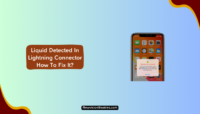You may accidentally drop your phone in a pool, spill a drink, or get caught in the rain. Whatever the reason, getting the water out of it as soon as possible is necessary to make it work again. Luckily, there are ways to get the water out without wrecking the phone further.
In this article, we will tell you how to quickly get water out of Charging Port so you don’t have to mess with your phone.
Dropping a phone in water or spilling liquid often leads to big trouble. The charging hole where you plug in the cable can get filled with water. This water will stop your phone from charging or making it act strangely. Also, water in the charging port is a nuisance that messes with your phone.
Following the methods mentioned here, you can drain water from phones and make them work like new ones again.
How To Get Water Out of Charging Port?
While liquid detection alerts can provide an early warning about water damage, removing the liquid is critical to minimizing harm and repair costs. The methods for draining water from charging ports and other openings are similar across Android and iOS devices. The methods we have discussed have saved countless phones from replacement, and your device can be the next. Follow the methods carefully and have hope – your device may just come out the other side undamaged or fully functional again.
1. Remove The Moisture:

Gently shake out as much excess water from the charging port as possible. If you want, then you can also use a can of compressed air to blow out any remaining droplets. Be careful not to insert objects into the port, like toothpicks, paper clips, etc., as these can damage your device’s internal parts and connections.
It is best to avoid touching the inside of the port when possible. If your device has got wet in front of your eyes, you can take a piece of cotton cloth to absorb as much water as possible. This will ensure that water doesn’t reach more parts or stay for long in your device. Don’t forget to switch off your device before cleaning it with a cloth.
2. Let It Evaporate Itself
If water was spilt on the surface of the charging port opening, letting the phone sit undisturbed for several hours may allow enough moisture to evaporate. But this depends on good air circulation and only when the phone is not too much wet.
- Ensure the charging port is uncovered so air can flow through and humidity escape.
- If possible, place the phone in front of fans or a warm, low-humidity environment.
- Do not turn on the phone during this process, as it can damage other parts.
- Do not use heating elements or try to make your phone warm by using any other electrical appliances, as it won’t help but will damage the internal parts.
3. Try Using A Wireless Charger:
If you can turn on your phone and it supports wireless charging via a charging pad, you can utilize the magnetic field created by the pad to transfer power to the phone despite some remaining moisture. Placing the phone on the pad briefly can help gradually remove more trapped water through induction heating and evaporation.

But water damage can still occur over time, so phone monitoring is important. We recommend you keep the phone switched off while charging it and if it is wet. Also, follow this method only when you have original charging equipment and devices because a change in the power can cause electrical malfunctions in the device or charger.
4. Use The Silica Gel:
Silica gel packets are very effective at absorbing humidity and drying out electronics. Place 2-3 silica gel packets in an airtight bag or container with your phone. The silica gel will absorb trapped moisture from the air and inside the phone. Check the colour change of the silica gel from blue to pink, indicating it is saturated.

Silica gel can then be reactivated in an oven and reused. This method may require packet changes every day or two to dry the phone fully. You must follow this method only after drying the device as much as possible. The method won’t help you remove too much humidity or water from your device, so consider it an add-on.
5. Visit A Service Centre:
It is best to have a certified phone repair shop service your device for severe water damage that prevents proper function or continued issues. They have heavy-duty tools, replacement parts, and highly trained technicians able to thoroughly dry, clean, and repair water-damaged phones without damaging any part.

They can easily identify if any permanent damage has occurred and perform repairs or replacements needed to get your phone working properly again. Professional servicing provides the most comprehensive solution for data retrieval, component drying, and malfunction correction after water damage. You can visit a certified or authorized service centre for your device’s checkup.
Uncommon Ways To Get Water Out Of Charging Port:
While common methods like silica gel, drying using a cloth, and evaporation work well for removing light water damage. You may need to get creative for severe submersion cases, which many people lack. The techniques mentioned below are uncommon but have been shown to rescue phones that seemed permanently waterlogged successfully.
It’s important to know that these methods may not work for everyone and could damage the charger more. However, if you are in a hurry and need to get water out of the charging port fast, they are worth a try.
6. Let Rice Soak The Water:

The method of using rice to absorb moisture from electronics is tried and true. Regular white rice not cooked, is wonderful at soaking up water. Simply fill an airtight bag or container with rice and put your phone inside. Leave the container overnight; the rice will draw the water from your phone.
7. Use A Cotton Swab Or Towel:

If you’re in a hurry, using cotton swabs and white towels to absorb the water is a quick fix. Gently wipe out any loose debris from the ports with a cotton swab (but do not force it inside). Then use a clean, dry towel to buff the ports and any other part where water could hide. Repeat this process a few times and then let your phone sit.
8. Keep It In The Sun:

Sun exposure is nature’s hair dryer, and it is one of the best solutions to make something dry, and you can use it with the rice method as well. Place your phone in a bag of uncooked rice and leave it in direct sunlight for several hours. The UV rays will help evaporate any trapped water, and the rice will absorb it instantly.
9. Vacuum Cleaner Or Hair Dryer:

You can use a vacuum cleaner, hose, or hair dryer on a low setting when all else fails. Hold the hose or blow dryer several inches from the port and slowly move it around to redirect the airflow over and into the ports. The suction and heat will pull the water out while avoiding damage. Be very careful not to overheat any components.
Things To Avoid When Your Charging Port Is Wet:
Water severely damages electronic equipment, making them useless and demanding costly repairs or replacements. While everyone tries to keep their devices dry, accidents can happen anytime. We have already shared some working methods to get water out of the charging port on mobile devices, and it is essential to keep some things in mind.
There are several methods and precautions that you can take to ensure your device remains dry, such as using waterproof cases, avoiding usage in wet conditions, and handling the device with care. Below we have shared some important things that everyone must keep in their mind to minimize the effects of water damage effects.
1. DO NOT CHARGE:
Charging a device immediately after water has entered the charging port can lead to a short circuit, electric shock, or even an explosion. It is best to avoid charging altogether when liquid exists within the port. Further charging will only worsen any damage already incurred due to water exposure.
2. Do Not Blow Into The Port:

Blowing into the charging port to clear out any water is useless because the force from blowing will eventually push water deeper into the device. If this happens that the water can cause permanent harm to the circuit and components. Don’t blow air directly into the charging hole; instead, use a hair dryer at a distance so only hotness reaches the port.
3. Don’t Try To Shake:
Shaking, tilting, or roughly moving a device after the liquid enters will generate more splashes and spills. Internal parts like wires, chips, and connections can become damaged or detached due to motion and vibration. Leaving the device stationary is the safest approach, and you should take it to a service centre if you don’t know what you are doing.
4. Avoid Inserting Foreign Objects:

Inserting foreign objects into the charging port or any openings to clear the blockage or retrieve stuck water will likely lead to scratches, punctures, and physical damage to internal parts. Things like paper clips, toothpicks, safety pins, etc., should never be inserted into the charging port of mobile devices.
5. Do Not Use Isopropyl Alcohol:
Isopropyl alcohol may evaporate some surface water, it will not fully remove submerged or trapped liquid, and the alcohol can also damage certain components on contact. A lot of people think it might work, and it does, but not with electronic devices like smartphones.
How Can Liquid-Detection Alert Save Your Device?
Liquid detection sensors can alert you quickly if water damages your device. These sensors can detect if the liquid has entered the charging port or other phone openings. Once the liquid is detected, the sensor will immediately warn you about the wet condition. This early alert allows you to act fast and take steps to dry out the liquid before it causes permanent harm.

The sensor alerts can save your device from major water damage by providing a heads-up. Almost every phone manufacturer has started adding this feature to their devices, and you can find them in iPhone, Samsung, or OnePlus devices. Staying informed quicker about liquid issues provides more options to address them effectively. If buying a new device, consider getting one with this feature.
Final Words:
Getting water in the charging port of electronic devices is never fun, but the good news is there are simple solutions to fix the problem without breaking the bank. The key is staying calm and avoiding rash moves that might cause more damage. Uncooked white rice, silica gel packets, vacuuming, or blow drying on a low setting usually works fine.
Once your device is dried out, inspect it closely for any visible signs of damage before reusing it as normal. It’s best to have repairs done by a professional if the water issue causes permanent problems. You can keep visiting the New Vision Theatres, as we will keep this post updated with more information on how to get water out of the charging port.
Hi, I am Anshul Mathur. A Cisco Certified Network Associate and Blogger from Sikar, Rajasthan. I love digging deep into the technology world, therefore I write about it on this blog.






